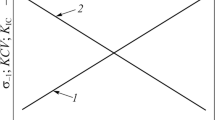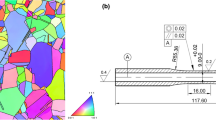Abstract
Stress-controlled uniaxial push-pull fatigue tests were carried out with cylindrical specimens of low carbon steel with a carbon content of 0.1 percent. Resistent heated grips provided testing temperatures up to 550°C. During all fatigue tests the time-dependent strain was measured. The strain at zero load, the plastic strain amplitude plotted against the number of cycles is known as the cyclic deformation curve. At room temperature, this curve depends on the applied stress amplitude. The shape of the cyclic deformation curve at the same stress amplitude is strongly temperature-dependent. In the temperature region of blue brittleness the endurance shows a maximum connected with a very low plastic strain amplitude. Also the cyclic stress strain curves have a different appearance within varied temperature ranges.
The observation of the dislocation structure of the specimen's interior after fatigue damage by means of the transmission electron microscopy showed different pictures within different temperature regions. For instance, besides other structures at other temperatures, dislocation channeling was found, connected with a cyclic softening process which is evident from the cyclic deformation curve. The dislocation structures of specimens fatigued at various conditions differ from “clouds” to “cells”, “channels”, “walls”, and “blocks”.
Résumé
Des essais de fatigue traction compression uniaxiale en contrainte contrôlée ont été éffectués sur des éprouvettes cylindriques d'acier à bas C, le carbone étant de 0,1%. Grâce à des mordaches résistant à la température, on a pû réaliser des essais jusque 550°C. Durant tous les essais de fatigue, on a mesuré la dilatation en fonction du temps.
La déformation à charge nulle ou amplitude de déformation plastique portée en diagramme en fonction du nombre de cycles est connu comme la courbe de déformation cyclique. A la température ambiante, cette courbe dépend de l'amplitude des contraintes appliquées. La forme de la courbe de déformation cyclique à même amplitude de contrainte dépend directement de la température. Dans la région de température correspondant à la fragilité au bléu, l'endurance fait état d'un maximum en relation avec une très faible amplitude de déformation plastique. On constate également que les courbes de contrainte et de déformation cyclique ont une forme différente suivant la gamme de températures.
L'observation de la structure de dislocation à l'intérieur d'un échantillon soumis à dommage de fatigue montre, en utilisant une microscopie électronique par transmission différents aspects suivant les zones de températures différentes atteintes. Ainsi, parmi diverses structures correspondant à d'autres températures, on a constaté des alignements de dislocations en connexion avec un processus d'adoucissement cyclique qui apparait clairement à partir des courbes de déformation cyclique. Les structures des dislocations des éprouvettes soumisses à fatigue sous diverses conditions prennent la forme de “nuages”, de “cellules” d“alignements” de “parois” et de “blocs”.
Similar content being viewed by others
References
F.C. Lea and H.P. Budgen, Engineering (Oct. 3, 1924)500; (Oct. 10, 1924) 532–534.
H.J. Tapsell, Journal of the Iron and Steel Institute 117 (1928) 275–294.
W. Schwinning, M. Knoch and K. Uhlemann, Wechselfestigkeit und Kerbempfindlichkeit der Stähle bei hohen Temperaturen, VDI-Z, Bd. 78, Nr. 51 (Dec. 1934) 1469–1476.
K. Uhlemann, Metallwirtschaft, Wissensch., Technik Nr. 39 (Sept. 1935) 773–778; Nr. 40, 795–798.
M. Hempel and H.-E. Tillmanns, Archiv f.d. Eisenhüttenwes. H. 9 (March 1937) 395–403.
P.G. Forrest, Journal of the Iron and Steel Institute (June 1962) 452–457.
V.F. Terentjev, Fiz. metal. metalloved No. 6 (1969) 1088–1092.
B.M. Kawamoto, Y.J. Ibuki and H. Ishikawa, Fatigue strength and deformation for rotation bending at elevated temperatures, 14th Japan Congress on Materials Research Metallic Materials (March 1971) 42–47.
H. Abdel-Raouf, A. Plumtree and T.H. Topper in ASTM STP 519 (1973) 28–57.
D.V. Wilson and J.K. Tromans, Acta Metallurgica 18 (Nov. 1970) 1197–1208.
L.F. Coffin, Jr., Transactions of the ASME, Journal of Basic Engineering (June 1965) 351–362.
J.T. McGrath and W.J. Bratina, Czechoslovak Journal of Physics, B. 19 (1969) 284–293; Appendix: 418a-d.
D. Pilo Gonzalex, Zum Wechselverformungsverhalten normalisierter unlegierter Stähle mit Kohlenstoffgehalten von 0.01 bis 1,02 Gew.%, Dr.-Ing. Diss., University of Karlsruhe (TH) (1978).
A.H. Cottrell, Philosophical Magazine 44 (1953) 829–832.
A.E. Lord and D.N. Beshers, Acta Metallurgica 14 (1966) 1659–1672.
Author information
Authors and Affiliations
Rights and permissions
About this article
Cite this article
Pohl, K., Mayr, P. & Macherauch, E. Cyclic deformation behavior of a low carbon steel in the temperature range between room temperature and 850 K. Int J Fract 17, 221–233 (1981). https://doi.org/10.1007/BF00053521
Received:
Revised:
Issue Date:
DOI: https://doi.org/10.1007/BF00053521




